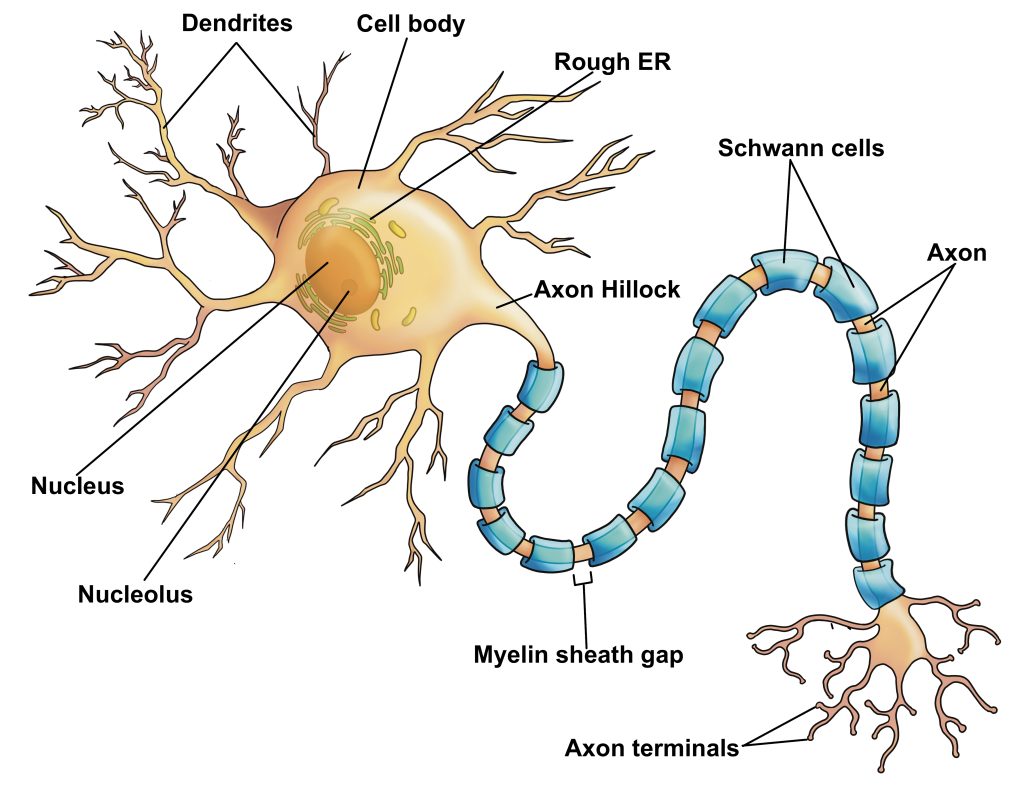Introduction to Nervous Tissue
Nervous tissue is a unique tissue type that allows our body to send and receive information incredibly quickly. Nervous tissue contains two different groups of cells:
- Neurons – excitable cells that can receive and send electrical signals
- Glial cells – cells that play an important role in supporting neurons and the nervous system (specific cell types will be discussed later)
This chapter will introduce the basics of nervous tissue. In-depth discussions of nervous tissue in the central and peripheral nervous systems will occur in a later chapter: Central and Peripheral Nervous Systems.
Neurons
A neuron is an electrically excitable cell that receives and sends information allowing communication within the body. The neuron can be broken down into three basic parts, as seen in Figure 1:
- Dendrites – receive stimuli (signals/information) from environment or other neurons, which are conducted to the axon
- Cell body – contains nucleus and organelles (biosynthetic center)
- Axon – axon hillock of the cell body narrows to become the axon, which transmits electrical signals to the axon terminus to communicate with other cells
Figure 1: The basic parts of a neuron

Under the microscope, the cell body or soma is prominent (Figure 2). However, the rough endoplasmic reticulum and other organelles appear as a granular substance called Nissl bodies. In Figure 2, we can see the cell body with numerous neuron processes extending from it, though we can not distinguish whether the neuron processes are dendrites or axons.
Figure 2: Nervous tissue highlighting the basic parts of a neuron and the cell bodies of glial cells, with and without illustration overlay
Check out our YouTube video to help you understand nervous tissue:
YouTube Video – Nervous Tissue
Glial Cells
There are many types of glial cells, which all share the common function of assisting/supporting the neuron. In the Central and Peripheral Nervous Systems chapter you will learn more about specific types of glial cells in the central and peripheral nervous systems. Due to the staining procedure and light microscope resolving power, we can often only observe the nuclei of glial cells (Figure 3).
Figure 3: Nervous tissue highlighting the basic parts of a neuron and the cell bodies of glial cells, with and without illustration overlay
Chapter Illustrations By:
Edna Martinez Sanchez
Georgios Kallifatidis, Ph.D
excitable cells that can receive and send electrical signals
cells that play an important role in supporting neurons and the nervous system
receive stimuli (signals/information) from environment or other neurons, which are conducted to the axon
contains nucleus and organelles and serves as the biosynthetic center of the cell (synthesizes biological molecules)
axon hillock of the cell body narrows to become the axon, which transmits electrical signals to the axon terminus to communicate with other cells
means "body"
granular substance in neuron cell body caused by the staining pattern of the rough ER
